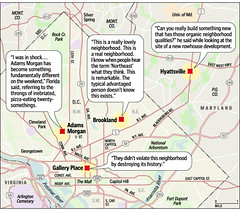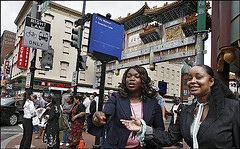Do you really need Richard Florida?
 Post graphic by Nathaniel Vaughn Kelso.
Post graphic by Nathaniel Vaughn Kelso.Entry: Monday September 18, 2006
As in today's Post article, "The City as Modern Muse," subtitled "Richard Florida Muses on Cultivating Washington's 'Creative Class'," who granted, has shaped our thinking tremendously, to understand the value of creativity and authenticity?
Historic preservation-based urban revitalization has been proving this for 40+ years. Whereas The Rise of the Creative Class: And How It's Transforming Work, Leisure, Community and Everyday Life was published in 2002, the books Changing Places: Rebuilding Community in the Age of Sprawl (1997), The Living City: How America's Cities Are Being Revitalized by Thinking Small in a Big Way (first edition published in 1987), and Cities Back from the Edge: New Life for Downtown (1998) predate (and support) the thesis. Even Charles Landry's work on the creative impulse in cities, such as The Creative City: A Toolkit for Urban Innovators (2000) predates this.
Similarly, Jane Jacobs wrote about the value of a "large stock of old buildings" in The Death and Life of Great American Cities in 1961. She wrote this not because she was a preservationist, but because low-cost buildings are the most cost-effective places to foster innovation, change, and experimentation.
Also see Richard Florida's website.
 (Photo by Lucian Perkins, Washington Post.)
(Photo by Lucian Perkins, Washington Post.)I mean the caption of this photo is a hoot: "Tameka Kirk, left, and Nichole Burnette seek a cab in Gallery Place, a D.C. area that scholar Richard Florida says is mostly free of 'urban development crimes.'"
There are plenty of urban development crimes over there, but, enough of the historic building stock and rhythm at the street level has been maintained--along 7th Street NW from Pennsylvania Avenue practically to New York Avenue--that the foundation for urban vitality was there for rebirth. I have written a lot about this, and it is a subject for ongoing debate within the blog, and by commenters, but this area is succeeding despite the efforts of many developers to extract all the possible exchange value out of it (see the Verizon Center for one). If there weren't special zoning overlay requirements requiring arts-based uses, it would probably be a lot more barren than it is.
One of my biggest complaints is that most of the retail and restaurants along that corridor are not place-based, at least as far as DC is concerned. E.g., Legal Seafoods is a New England seafood concept when DC is part of the Chesapeake Bay region, which has a long and continuing tradition of its own. Etc.
Index Keywords: urban-revitalization



0 Comments:
Post a Comment
<< Home